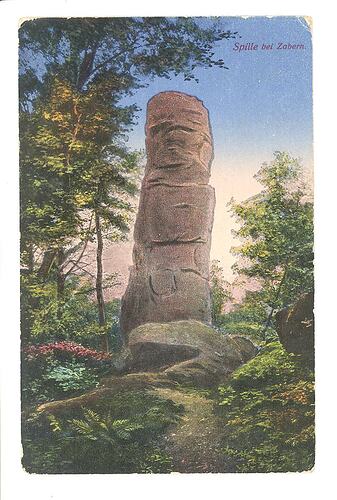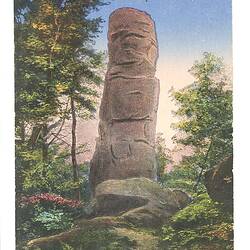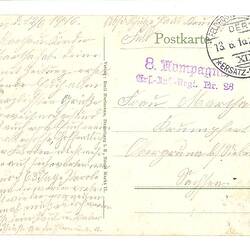Summary
Coloured postcard depicting 'Zabern', dated 13 June 1916. The handwritten letter on that back of the postcard is from a German soldier to his wife and children, thanking them for sending post, and expressing longing for his famiy. The letter hints at the tedium of life on the battlefield. It is not known how this particular postcard came to be in Australia.
'Zabern' is the German name for the French town Saverne, located in Alsace, outside Strasbourg. The place became known due to the Saverne Affair (German: Zabern-Affäre), a crisis of domestic policy in the German Empire at the end of 1913. It was caused by political unrest in Zabern, where two battalions of Prussian Infantry Regiment 99 were garrisoned, after a second lieutenant insulted the Alsatian population. The affair not only put a severe strain on the relationship between the imperial state of Alsace-Lorraine and the remainder of the German Empire but also led to a considerable loss of prestige for the German Emperor.
During World War I around 11 billion letters or postcards were sent from the front free of charge through the German Army Postal Service. Millions more letters were sent to the front by families and friends at home. From 29 April 1916 onwards postal service stations were set up at every army command station in order to monitor the content of the mail and to create reports on the content. The transmission of classified military or rebellious and discouraging information was prohibited.
Physical Description
Colour postcard showing a rock formation in a forest. A small track leads up to the rock formation. Inscription names the place as "Spille bei Zabern". On the back is handwritten text. Postcard shows signs of wear around the edges.
Significance
The colour postcard is an invaluable record of a contemporary witness from the First World War. The postcard is send through the German army postal service to communicate with family and friends at home. The message depicts themes such as longing for loved ones and life as soldier at the time of the Great War.
More Information
-
Collecting Areas
-
Acquisition Information
Purchase
-
Date Written
-
Place Depicted
-
Inscriptions
Front: Spille bei Zadern (translated: Spille near Zabern) Back: in print "Postkarte", Verlag: Emil Hartmann, Strassburg i.E, Neuer Markt 11. (translated: "postcard", Publisher: Emil Hartmann, Strassbourg i. E, New Market 11) date stamp of the army postal service: 13.6.16; XIX. Ersatz-Division (replacement division); 8. Kompagnie Ers.-Inf.-Regt. Dr. 23 handwritten in pencil: Address and text in old German handwriting Suetterlin. Handwritten: Absd. Paul Krumsfert[???] / Feld [Postkarte] Frau Martha / Krumsfert[???] / Obergruna b/ Siebenlehn / Sachsen [W_ge___], d. 12/6 1916 / Liebe Martha u. Kinder / Liebe Martha habe deine / Karte mit Zeitung erhalten / Und schicke Euch allen / Die herzlichsten Grüße / Bin so weit noch gesund / was ich auch von Euch meine / lieben allerhöchste, hoffentlich / läßt der Frieden nicht mehr / so lange auf sich warten. [Wir] / zählen noch 63 Tage _arole / und wann die [werden?] ___ bei / sein geht wieder von neuen / los einmal muß es sich [wenden?] / Mit Gruß dein Paul u. Varter / Viele Grüße an die Eltern ______. Translation: Sender: Paul Krumsfert [???] / Field postcard Mrs Martha / Krumspfert[???] / Obergruna near Siebenlehn / Sachsen ________ 12 June 1916 / Dear Martha and Kinder / Dear Martha I received your / card with newspaper / and send all of you / the warmest greetings. / So far I have kept well / which I hope is the same for all / of you, my dearest loves, hopefully / peace will not make us / wait much longer. [We] / have 63 more days _____ / and when the [_______ become] / it starts all over again / at some point it has to [change?] / [With love/greetings] / your Paul and father / Greetings to the parents_____ [presumably grandparents].
-
Classification
-
Category
-
Discipline
-
Type of item
-
Overall Dimensions
140 mm (Width), 90 mm (Height)
-
References
Information on World War I German postal service from German History in Documents and Images (GHDI) web site [Link 1] accessed 9/2012.
-
Keywords


